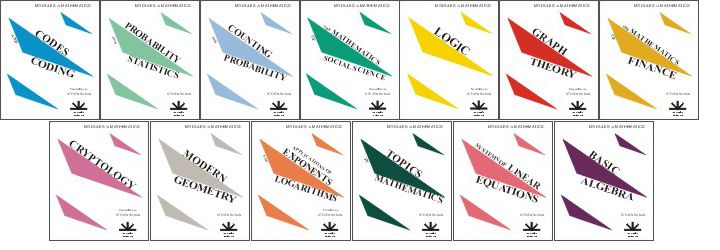 The Mathematics of
Social Science
The Mathematics of
Social Science
There are currently 13 Modules in Mathematics, all authored by Steven Roman. The titles are listed below, followed by a brief description of each, with tables of contents. Click on a title to see the description, or simply use the navigation keys to browse the entire list.
 The Mathematics of
Social Science
The Mathematics of
Social ScienceAn elementary discussion of how mathematics may be used in the social sciences. Requires only basic arithmetic skills. Chapter 1 contains a discussion of how to form a group ranking of products, based on a set of individual rankings. The chapter concludes with a brief discussion of the famous Arrow Impossibility Theorem. Chapter 2 is devoted to measuring an individual's power, or influence, in a group setting. For instance, how much more power does a permanent member of the U.N. security council have than a temporary member? Chapter 3 contains a discussion of various methods for apportioning seats in the U.S. House of Representatives—a very important contemporary political problem. The final section gives a fascinating historical perspective on this 200 year old problem.
 Graph Theory
Graph Theory
Requiring no formal mathematical background, this modules provides a wide-ranging introduction to graph theory and its applications to various areas of applied science.
 Codes and Coding
Codes and Coding
A survey of the contemporary topic of codes and coding. Prerequisites are minimal, since all of the necessary mathematics is developed in the module. Chapter 1 contains a discussion of the ubiquitous check digit codes that are used for error detection, and can be found in a wide variety of common circumstances, such as Universal Product Codes (Bar Codes), credit card numbers, bank check numbers, driver's licence numbers and ISBN's. We compare various commonly used methods and show which ones work best for detecting errors. Chapter 2 contains a discussion of the most famous code of all — the Hamming code for error correction. The final chapter discusses the Huffman coding scheme, which is used to encode data for space saving purposes (rather than for error detection or correction).
 Logic
LogicThis module requires no special mathematical background. Its aim is to acquaint the student with the basics of symbolic logic, such as how to correctly use DeMorgan's Laws, what the difference is between a conditional statement and its converse and how to recognize when an argument is logically valid. The module concludes with a brief discussion of how logic can be used to design circuits.
 Counting and
Probability
Counting and
ProbabilityAn introduction to counting techniques and elementary probability that requires only high school algebra.
 Probability and
Statistics
Probability and
StatisticsThis module contains less probability than Counting and Probability, second edition or alternate second edition. However, it does include a chapter on rudimentary statistics.
 The Mathematics of
Finance
The Mathematics of
FinancePrerequisites are intermediate algebra. The goals of this module are to introduce the basic terminology related to interest, loans, leases and bonds; to show how various quantities, such as the monthly payments on a loan, can be computed using mathematical formulas; and to show how business calculators are designed to make these computations easier. Examples are done using a scientific calculator, the TI BA II Plus and the HP 10B. This module would make a nice supplement to a course in business calculus.
 Cryptology
CryptologyAn introduction to the fascinating field of secret messages, requiring no formal mathematical prerequisites for the first chapter, and an acquaintance with exponents for the second chapter. Chapter 1 describes some traditional, pre World War 2 methods for encoding messages. In Chapter 2, the author discusses one of the most used contemporary methods for encoding — the RSA method. At present, this method is believed to be secure, but may prove otherwise if efficient methods for factoring large numbers are ever discovered!
 Applications of
Exponents and Logarithms
Applications of
Exponents and LogarithmsThis module shows how exponents and logarithms play a role in the processes of growth and decay. Prerequisites are intermediate algebra. After a short review of logarithms, there follows a discussion of compound interest. The next section is devoted to the time value of money, including how to compute the payments on an auto loan or home mortgage. Then comes a discussion of famous logarithmic scales, such as the Richter scale. The final section concerns the exponential growth of organisms and the decay of radioactive substances.
 Modern Geometry
Modern Geometry
An introduction to some of the most interesting topics in modern geometry, including tilings of the plane and fractals.
 Topics in
Mathematics
Topics in
MathematicsEach chapter of this module is independent of the others, and contains a different topic in mathematics. The only prerequisite is intermediate algebra. This module would make a nice supplement to a precalculus course.
 Systems of Linear
Equations
Systems of Linear
EquationsAn introduction to matrices and systems of linear equations, with an emphasis on applications. Prerequisites are high school algebra only.
 Basic Algebra
Basic Algebra
The first two chapters of a standard college algebra book, this module is designed for self-study and as a supplement to a calculus course for those students who need a little review or reference in algebra.